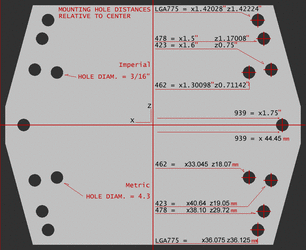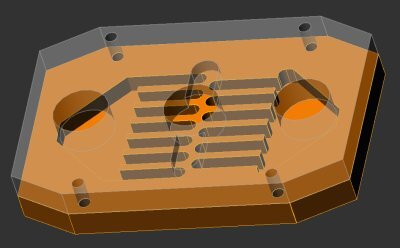Okay well its been about 2 years since i watercooled my first computer.
I loved the results and I loved building it. It was challenge the first time out but because I am a machinist by trade I was able to make a direct one to one copy of what is now called(i think) the RBX. you know, the one with the three barbs and the "micro-fins" in it. The thing worked great and i was rarely above 35C even when raising the voltages high.
Well I'm back to try my hand again at creating my own rig. I plan on buying one of the new Intel core 2 duos. I've never used intel and am unaware how mounting works on them.
The question i have is fairly simple. Can someone direct me in the direction of the best waterblock on the market right now that will fit the new Intel CPU's so i can begin making one and give me some ideas on how people are locking them down to the mother board.
I'm hoping to find time to make my own case for this with enough room to fit everything inside of it and to put the radiator, res, and pump in their own compartment so i can keep the heat from the rad and pump out of the mobo area.
I'm probably going to have extra copper left over to make extra blocks when im done so ill probably be selling em off for like 10 to 20 bucks each on ebay to try and recoup the money for the rig. No worries about copywrites. i don't plan on making a direct one to one i just want some good ideas for something that will work good and fit the new type of proc im using.
I loved the results and I loved building it. It was challenge the first time out but because I am a machinist by trade I was able to make a direct one to one copy of what is now called(i think) the RBX. you know, the one with the three barbs and the "micro-fins" in it. The thing worked great and i was rarely above 35C even when raising the voltages high.
Well I'm back to try my hand again at creating my own rig. I plan on buying one of the new Intel core 2 duos. I've never used intel and am unaware how mounting works on them.
The question i have is fairly simple. Can someone direct me in the direction of the best waterblock on the market right now that will fit the new Intel CPU's so i can begin making one and give me some ideas on how people are locking them down to the mother board.
I'm hoping to find time to make my own case for this with enough room to fit everything inside of it and to put the radiator, res, and pump in their own compartment so i can keep the heat from the rad and pump out of the mobo area.
I'm probably going to have extra copper left over to make extra blocks when im done so ill probably be selling em off for like 10 to 20 bucks each on ebay to try and recoup the money for the rig. No worries about copywrites. i don't plan on making a direct one to one i just want some good ideas for something that will work good and fit the new type of proc im using.

